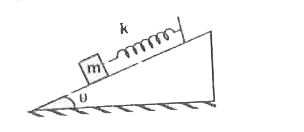A reference frame attached to the earth:
is an inertial frame by definition
cannot be an inertial frame because the Earth is revolving round the Sun
is an inertial frame because Newton’s laws are applicable in this frame
cannot be an inertial frame because the Earth is rotating about its own axis
The correct Answer is:B, D
A rotating or spinning frame is accelerating and hence non-inertial. Option (A) is wrong since Earth is an accelerated frame and hence cannot be an inertial frame.
Option (B) is correct.
Option (C) is incorrect, strictly speaking as Earth is accelerated reference frame (earth is treated as a reference frame for practical examples and Newton’s laws are applicable to it only as a limiting case).
Option D is correct
Topper's Solved these Questions
- DYNAMICS OF A PARTICLEBOOK - VMC MODULES ENGLISHCHAPTER - DYNAMICS OF A PARTICLEEXERCISE - JEE Main (Archive) Level - I
29 Videos
- DC CIRCUITBOOK - VMC MODULES ENGLISHCHAPTER - DC CIRCUITEXERCISE - JEE ADVANCED ARCHIVE
68 Videos
- ELECTROMAGNETIC INDUCTION & ALTERNATING CURRENTBOOK - VMC MODULES ENGLISHCHAPTER - ELECTROMAGNETIC INDUCTION & ALTERNATING CURRENTEXERCISE - IN-CHAPTER EXERCISE-G
10 Videos
Similar Questions
Assertion:− A particle on earth found to be at rest when seen from a frame U1 and moving with a constant velocity when seen from another frame U2. Then both frames may be non−inertial.
Reason :− A reference frame attached to the earth must be an inertial frame.
View SolutionA refrence frame attached to the earth
View Solution(A) : A reference frame attached to earth is a non inertial frame of reference.
(R) : The reference frame which has an acceleration is called a non inertial frame of reference.
View SolutionTwo satellites A and B of equal mass move in the equatorial plane of the earth, close to earth's surface. Satellite A moves in the same direction as the of the rotation of the earth while satellite B moves in the opposite direction. Calclate the ratio of the kinetic energy of B of that of A in the reference frame fixed to the earth (g=9.8ms−2 and radius of the earth =6.37×106m)
View SolutionTwo satellites A and B of equal mass move in the equatorial plane of the earth, close to earth's surface. Satellite A moves in the same direction as the of the rotation of the earth while satellite B moves in the opposite direction. Calclate the ratio of the kinetic energy of B of that of A in the reference frame fixed to the earth (g=9.8ms−2 and radius of the earth =6.37×106km)
View SolutionA block of mass m can slide along a frictionless inclined plane, is attached to a ideal spring of spring constant as shown in the figure. Find the period of its oscillation. (Frame of reference attached to the wedge is at rest)

View SolutionA +6μC point charge is moving at a constant velocity of 8×106ms−1 in the +y direction, relative to a reference frame. At the instant when the point charge is at the origin of this reference frame, what is the magnetic field vector it produces at the following points?
(a) x=0.500m,y=0,z=0, and (b) x=0,y=−0.500m,z=0.
View SolutionHere's another paradox from the theory of relativity. Let a spring be perpendicular to the speed of the reference frame. Acted upon by the force F, the spring extends by a length to l0=F0/k. As is well known, transition from one reference frame to another leaves the lateral dimensions unaltered (see Problem 6.1), therefore != lo- Isn't this in contradiction with the fact that as a result of such a transition the lateral force changes in accordance with the law F=F0√1−v2/c2?
View Solution(A):A balloon ascends from the surface of earth with constant speed.When it was at a height 50m above the ground,a packet is dropped from it .To an abserver on the balloon,the displacement of the packet,from the moment it is dropped to the moment it reaches the surface of earth is 50m.
(R ):Displacement vector does not depend upon the reference frame used to measure it.
View SolutionNewton's laws of motion are applicable in all inertial reference frames. Some physical quantities, when measured by observers in different reference frames, have exactly the same value. Such physical quantities are called invariant. In Newtonian mechanics mass, time and force are invariant quantities . On the other hand, some physical quantities, when measured by observer in different reference frames, do not have the same value. Sigmae physical quantities are called not invariant . In Newtonian mechanics displacement, velocity and work ( which is the dot product of force and displacement) are not invariant. Also kinetic energy(=12mv2) is not invariant.
Physicists believe that all laws of physics are invariant in all inertial frames, i.e. the work-energy principle states that the change in the kinetic energy of a particle is equal to the work done on it by the force. Although, work and kinetic energy are not invariant in all reference frames, the work-energy principle remains invariant. Thus even though different observers measuring the motion of the same particle find different values of work and change in kinetic energy, they all find the work energy principle holds in their respective frames.
Which of the following quantities is invariant?
View Solution
